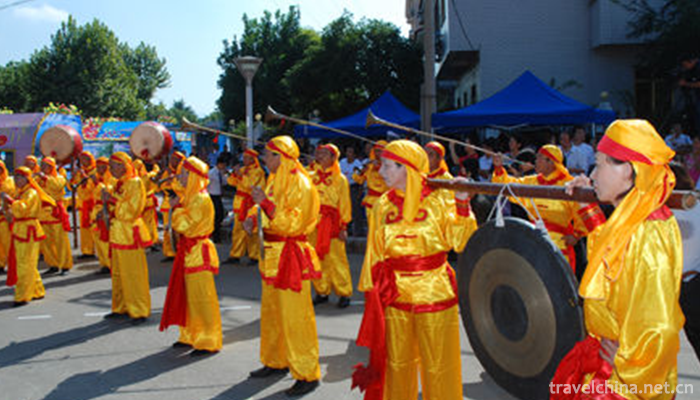Shengzhou Blows
Shengzhou blowing is one of the main components of "gong and drum in eastern Zhejiang". "Zhedong Gong and drum" generally refers to the traditional folk instrumental music in eastern and southern Zhejiang Province (commonly known as "drumming"). It differs from "silk and bamboo music" mainly in the use of rough blow instruments such as suona, pioneer and trumpet in Orchestra arrangement. The blowing and beating music in eastern Zhejiang has a long history. The Song Dynasty's Dream Lianglu and Ming Dynasty's Dream Memory of Tao'an are all recorded.
"Summer Rain" by Wei Qiyuan, a farmer in Bainikan, Huangze Town, was presented in Jinjing and received by Premier Zhou Enlai and other leaders.
On May 20, 2006, Shengzhou Blow was listed in the first batch of national intangible cultural heritage list with the approval of the State Council.
historical origin
Shengzhou Blow originated from temple fair culture and closely related to Buddhist music. It plays folk music with gongs, drums, erhu, Jinghu, three strings, cymbals, suona, trombones and other instruments.
According to records, as early as the Spring and Autumn Period and the Warring States Period, there were "villagers'community competitions" and temple fairs. There are temples and ancestral temples in villages, and there are stages in temples. Folk music such as Yuanmen, Embroidery Ball, Jealousy Flower, Shifan, Festival Poetry and General's Order, which are matched by them, emerge in endlessly. By the mid-Ming Dynasty, the playing groups engaged in percussion music were very popular in the middle of the Ming Dynasty. They were organized all over the villages and towns, including musicians'classes and Taoist classes who played religious music as professions, travelers' classes (also known as Hippie classes or sitting choirs) who sang operas and played blowing and beating, as well as "classes, churches and clubs" which played special instrumental music. They met with wedding and funeral celebrations, funeral sacrifices, worship ceremonies and worship ceremonies. Dragon lantern, lion dance and other activities are performed in close classes.
artistic characteristics
"Shengzhou Blow" is one of the main components of "gongs and drums in eastern Zhejiang". "Zhedong Gong and drum" generally refers to the traditional folk instrumental music of eastern and southern Zhejiang (commonly known as "drumming"). It differs from "silk and bamboo music" mainly in the use of rough blow instruments such as suona, pioneer and trumpet in Orchestra arrangement. Eastern Zhejiang has a long history of playing music. Song Dynasty's Dream Liang Lu and Ming Dynasty's Dream Memory of Tao'an are all recorded. "Shengzhou Blow" in the orchestra arrangement is characterized by the use of a combination percussion instrument "five small gongs, four big gongs". From 1949 to the 1980s, Shengzhou folk music gradually formed two major factions, East and West. The West Township group, represented by Changle Town Peasant Band, gradually formed a combination of gong, drum and blowing in its inheritance. Among them, the blowing method of the "sharp horn" changed the blowing performance to inspiration performance, which made the horn more exciting, penetrating and transmitting. This kind of inspiration playing method is very unique in the performance of national folk music and wind instruments. Its orchestra is composed of five gongs, three drums and three big gongs. Its playing instruments include suona, Trombone and other stringed instruments. The Dongxiang School, represented by Huangze Peasant Band, emphasizes the performance of silk strings, tends to be delicate and delicate in style, and its repertoire is mostly folk tunes and some traditional folk silk and bamboo music.
Representative Works
The main traditional repertoires of "Shengzhou Blow" include "Dayuan Gate", "Jealous Flowers", "Embroidery Ball", "Shifan", "Five Field Heads", "Yuanmen", "Embroidery Ball", "Jealous Flowers", "Shifan", "Festival Poetry", "General's Order", and so on. They are also representative repertoires of "Zhedong Gong and drum". Wei Qiyuan (1885-1970), a veteran artist of Baini Village Folk Music Club in Huangze Town, Shengzhou, compiled the folk instrumental music "Four Seasons Group Song" based on traditional music materials. Among them, "Summer Rain" won the special prize for performing in the second provincial folk music and dance concert in 1957. In the same year, he went to Beijing to participate in the national folk music and dance concert, recorded records, and was invited to perform for the national leaders in Huairentang, Zhongnanhai.
Inheritance Significance
Shengzhou folk music is the basis of Yueju opera music and an important part of Yueju opera. It also has a certain impact on the development of Yueju singing and accompaniment music. Shengzhou blowing is also one of the main components of "gongs and drums in eastern Zhejiang". It has important reference value for the production and development of folk music in eastern Zhejiang and the study of folk customs in eastern Zhejiang.

0 Questions
Ask a Question
Your email address will not be published.